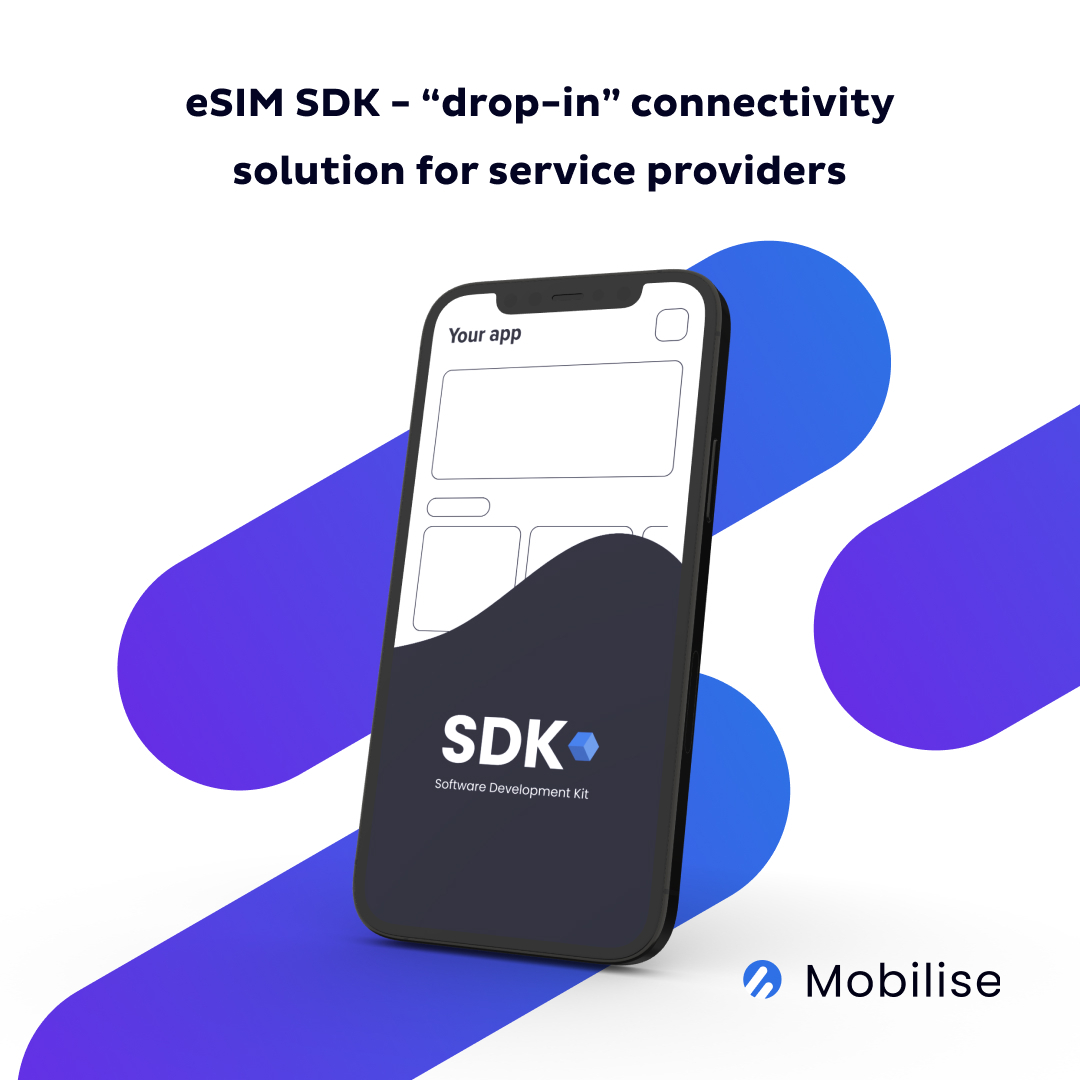eSIMs entered the consumer market in 2016. But only started getting the recognition it deserves when Apple launched its eSIM-only iPhone in September 2022. Now, eSIMs are entering, and slowly conquering, other industries such as travel. They’re a more affordable alternative to roaming. They’re also more convenient and secure than local SIM cards and public Wi-Fi, making it a perfect solution for international travellers. There was a lot of confusion surrounding the technology, so we’e taken it upon ourselves to answer your burning questions about eSIM explained.
RECOMMENDED READING
eSIMs allow service providers (SPs) in the telecoms industry to fully digitalise their customer journey and provide a new level of customer experience – something that both SPs and customers will benefit from.
In other industries, eSIMs are a perfect ancillary service that boosts revenue, customer satisfaction and loyalty – all while being ridiculously easy to implement and maintain.
Since eSIMs are in the spotlight, we thought it would be helpful to go through the basics of the technology and answer the most searched questions about eSIMs. Initially, this blog answered the 15 most common eSIM questions but we’ve now expanded it to 30!
1. What is eSIM?
In layman’s terms, an eSIM is a digital, non-removable SIM.
It has the same function as the plastic SIM card, but it’s physically integrated into the device — i.e., it can’t be removed from the device and replaced with another SIM. However, it doesn’t work on its own.
It requires the user to download an operator’s eSIM profile to make it work. The process takes place online and it’s fully digital, making the experience a lot better for the user.
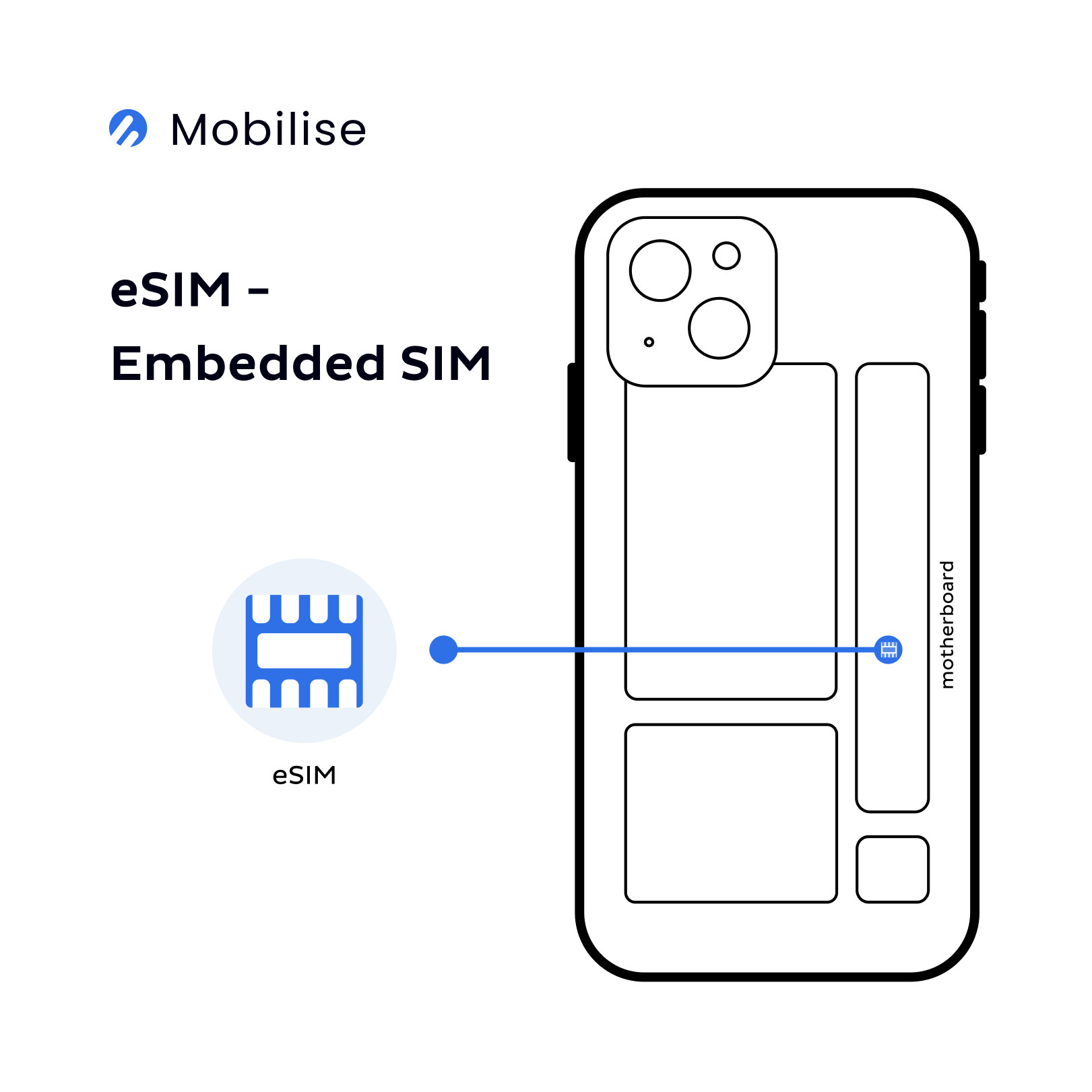
FIND OUT MORE ABOUT ESIM
2. When did eSIM come out?
eSIMs were initially introduced into the Internet of Things (IoT) sector in 2010 to take away the trouble of inserting and programming physical SIM cards into IoT devices.
It offers increased flexibility and streamlines the logistical nightmare of having to insert or swap SIM cards in unmanned and/or inaccessible connected objects.
Soon after, it became apparent that the same technology could be applied to consumer devices, with Apple being the main advocate of the movement.
GSMA was initially reluctant to introduce eSIMs to the consumer market due to security concerns. However, in 2016 the use of eSIM in consumer devices was approved, beginning a new era in the telecoms industry.
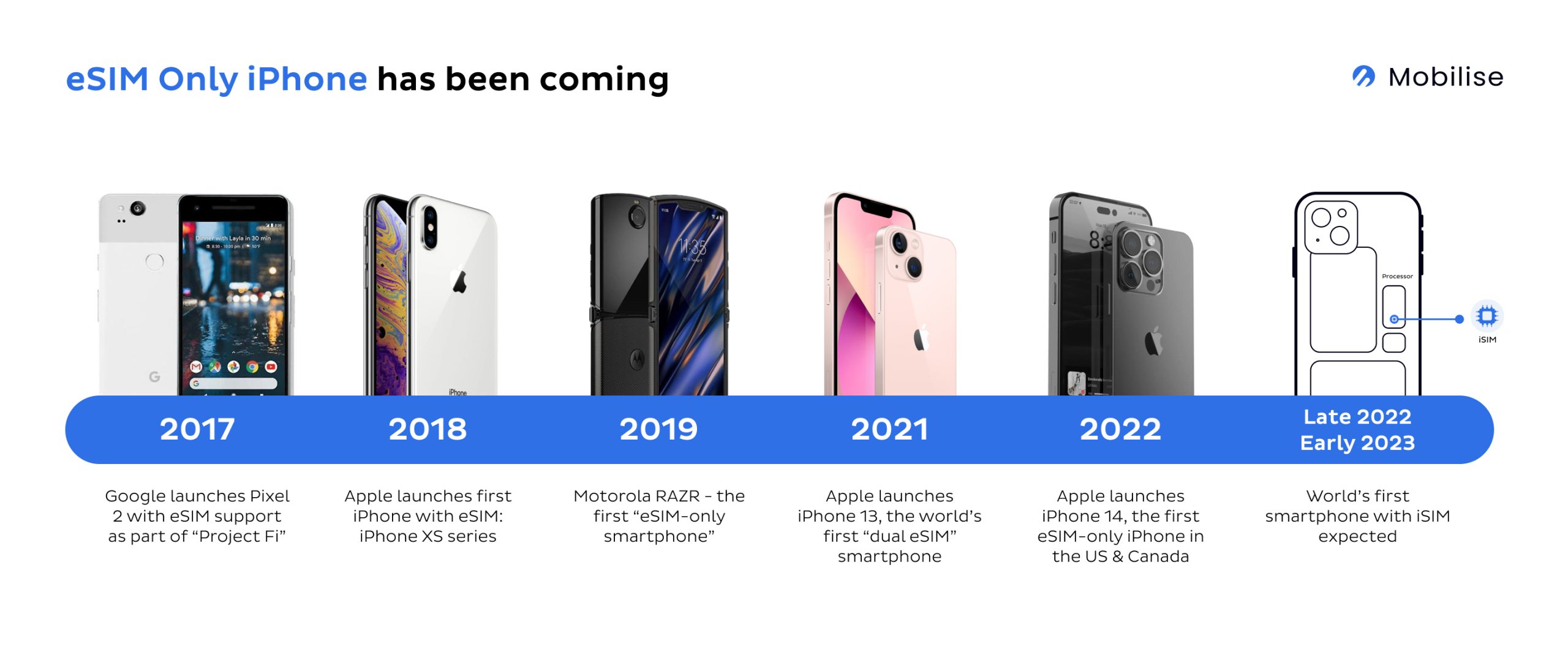
3. Who invented eSIM?
There is no single inventor of eSIM. The technology was developed by the Global System for Mobile Communications, widely known as the GSM Association or GSMA. The GSMA is a global organisation unifying the mobile ecosystem and representing the interests of mobile network operators worldwide.
4. How does eSIM work?
eSIM works just like a traditional plastic SIM card everyone is very familiar with. The only difference is the activation process. While the plastic SIM card needs to be inserted into a device, the eSIM is an intrinsic part of it and must be activated digitally.
Once an eSIM is activated, it works the same as a physical SIM.
Unlike physical SIMs, users can have multiple eSIM profiles on one device that can be used interchangeably from the phone settings. That eliminates the need of swapping physical SIMs, making the process smooth and convenient for the user.
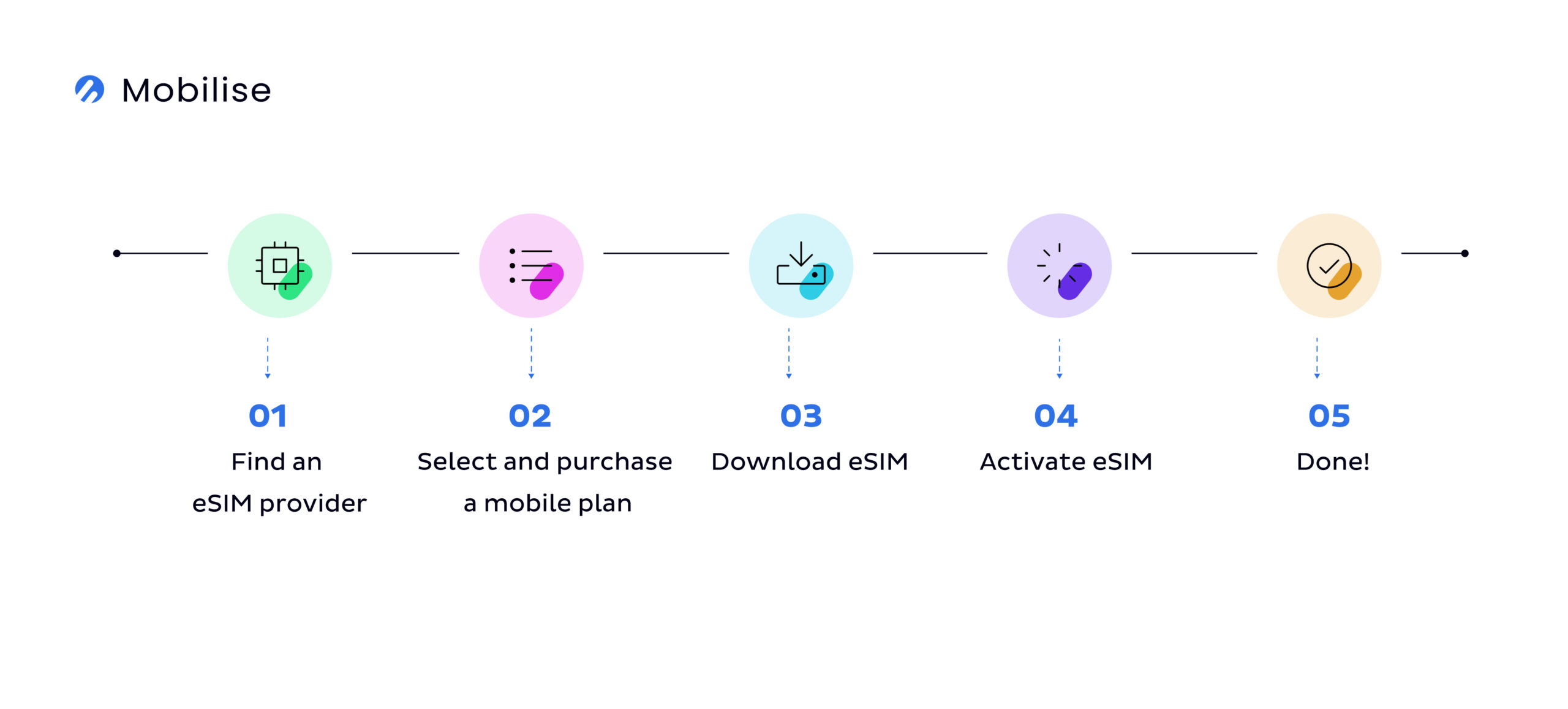
5. eSIM vs. physical SIM – what’s the difference?
Contrary to a plastic SIM card, eSIM doesn’t come with an operator profile data pre-installed in the device.
In order to connect to the operator’s network, a customer must provision their eSIM remotely. They need to download a SIM profile from their operator of choice and activate it on their device. The process takes as little as one tap and less than 60 seconds for the eSIM to activate.
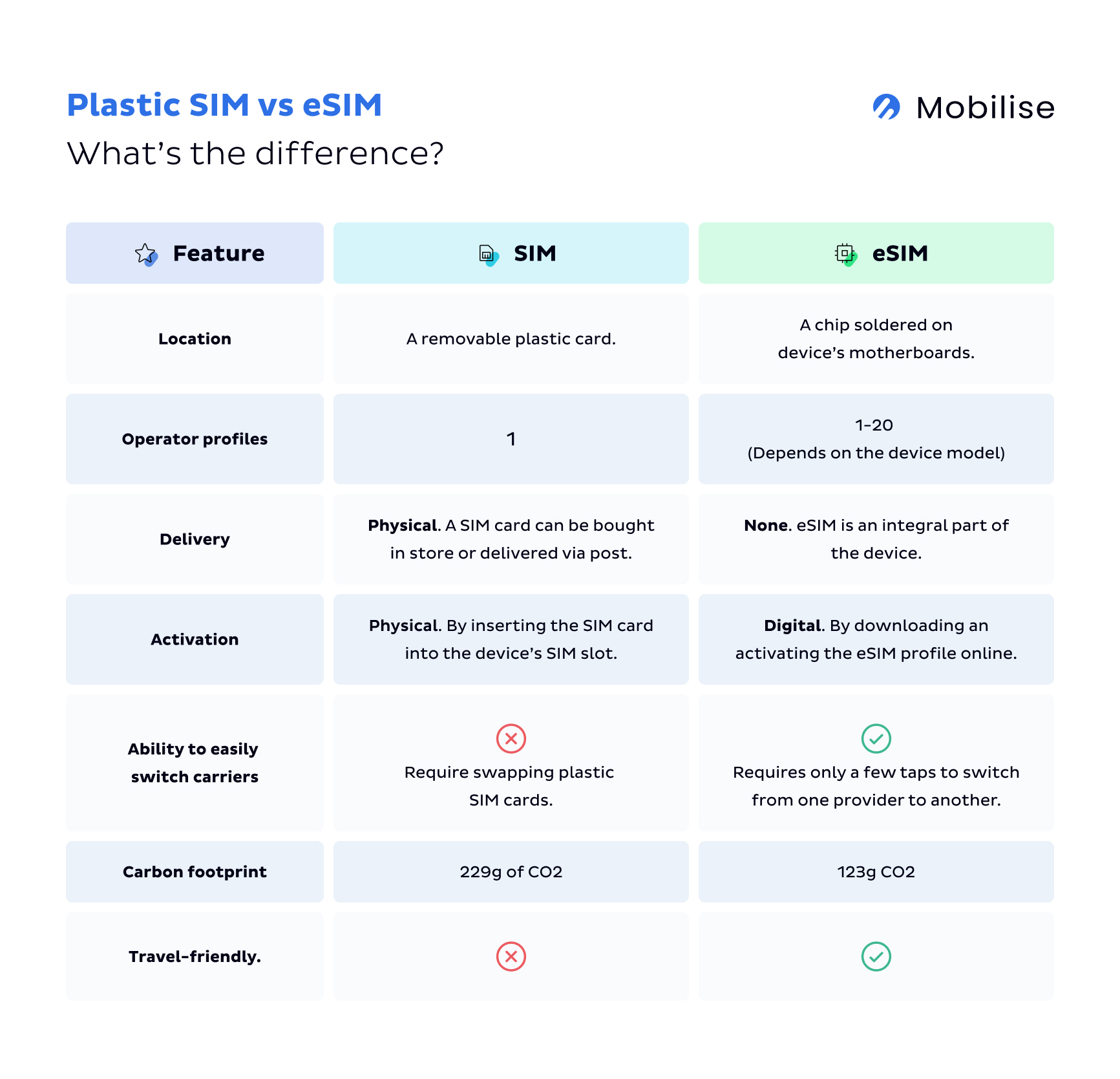
6. eSIM vs. Mini SIM | eSIM vs. Micro SIM | eSIM vs. Nano SIM
Mini, micro, and nano are just different sizes of a plastic SIM card. eSIM on the other hand is a chip that’s soldered inside the device.
Mini, micro, and nano SIMs have to be manually inserted into a device to get a user connected. eSIMs are a part of a device and cannot be removed or replaced.
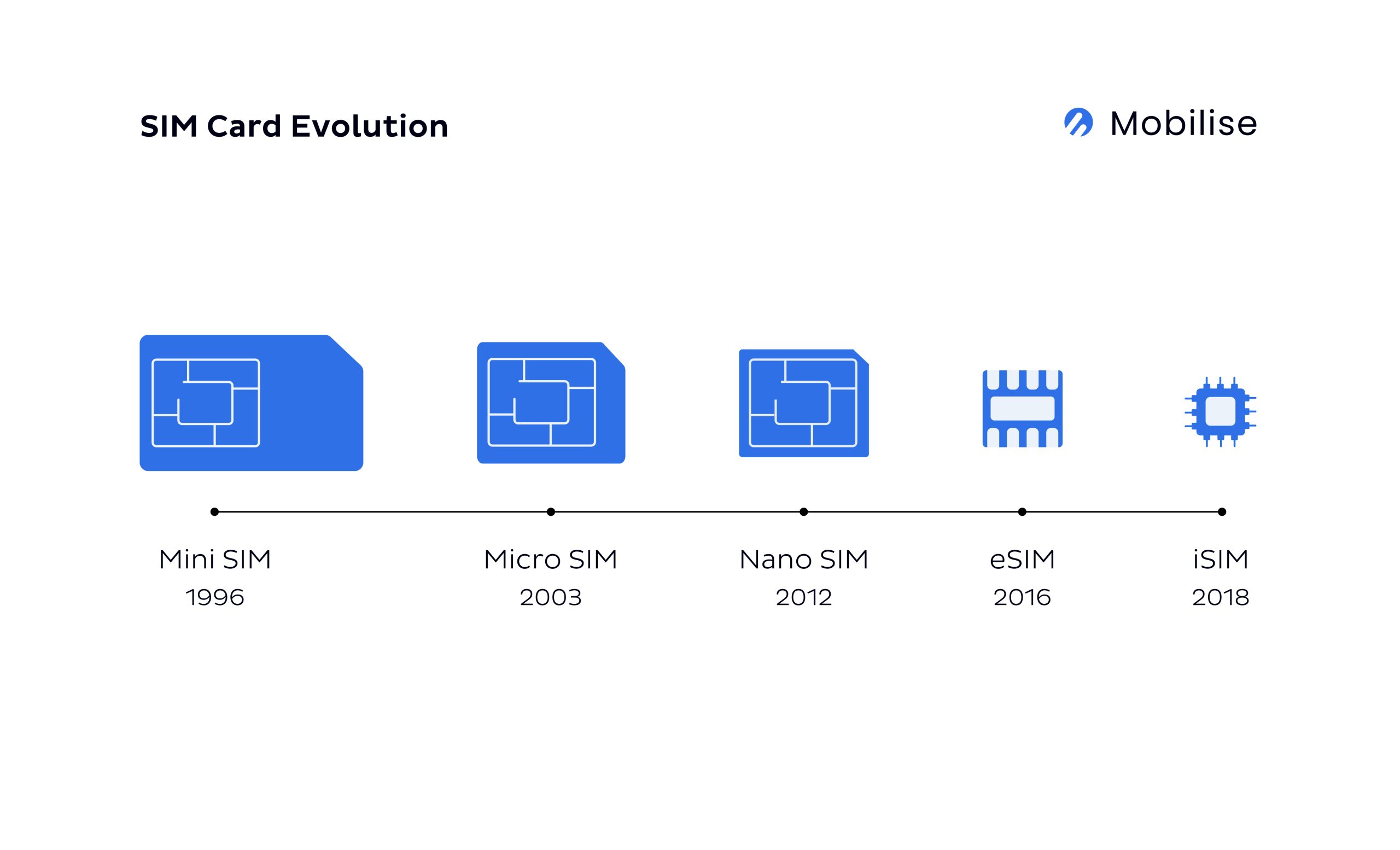
7. What is an eSIM profile?
An eSIM profile is the information about the operator that’s required for the identification and authentication of a SIM card with a mobile network.
In the case of plastic SIM cards, the operator profile is pre-programmed directly onto the SIM card and cannot be changed or removed.
In the case of eSIMs, it comes in a digital version and must be downloaded by the user onto the chip on their device. Most devices can hold multiple profiles at the same time and the user can use them interchangeably.
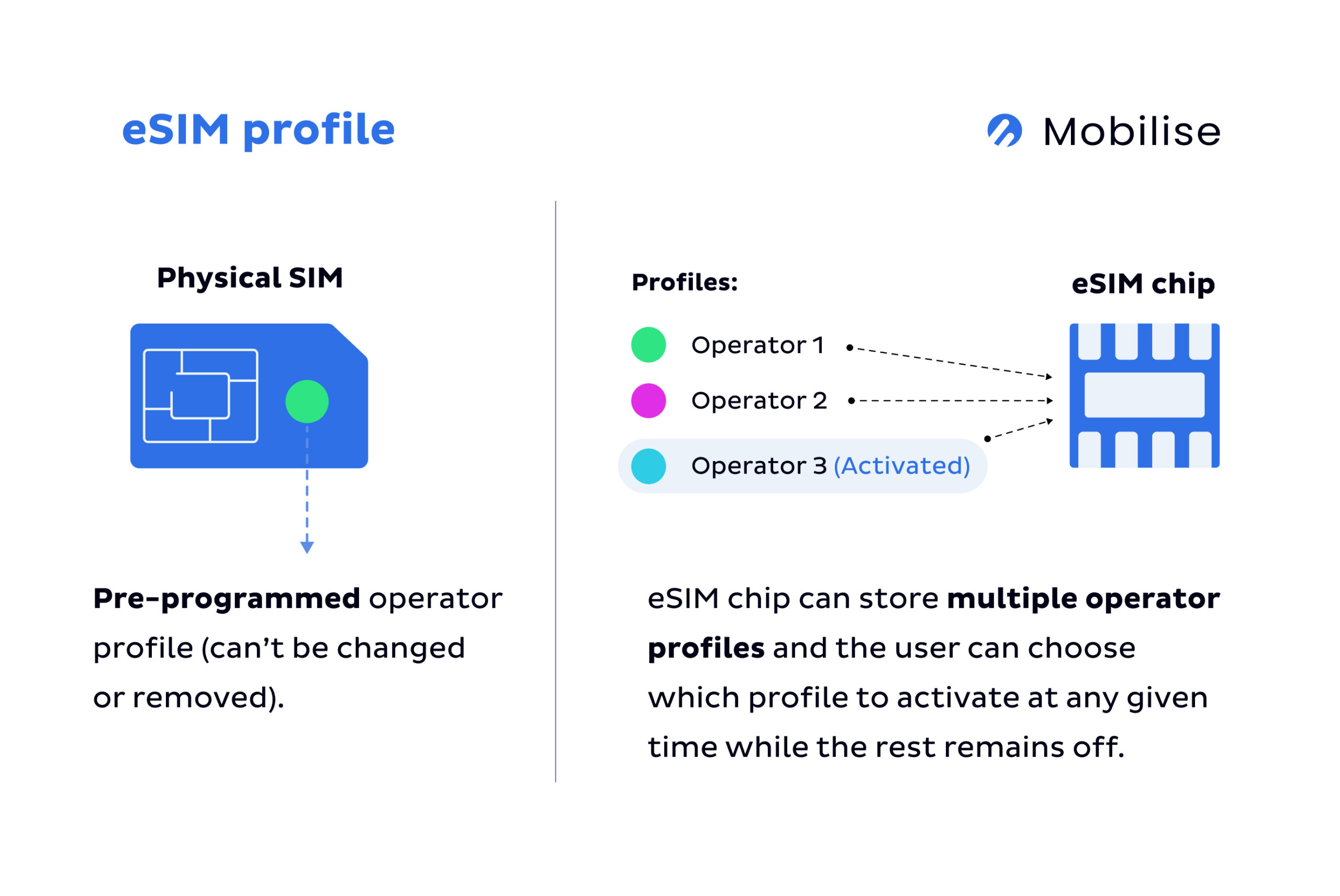
8. What is eUICC?
Traditional SIM is built on Universal Integrated Circuit Card (UICC) technology, just like bank cards. The UICC is a physically secure computing chip that can be used across multiple vertical sectors including mobile telecommunications. However, most devices can only host one UICC card. Some devices can hold two, they’re known as dual-SIM phones.
eUICC, or embedded UICC, is a hardware component that allows users to provision operator profiles remotely and can hold multiple operator profiles simultaneously.
eUICC is significantly smaller than the smallest SIM card – the nano SIM – and doesn’t need the space required for the SIM tray mechanics. Both features combined save a significant and very valuable space to device OEMs (original equipment manufacturers).
9. eSIM vs. eUICC – what’s the difference?
eSIM and eUICC tend to be used interchangeably, however, there is a difference between the two. eUICC and an eSIM chip are the same thing, however eSIM refers to the whole ecosystem – an eSIM chip with an activated eSIM profile on it. And to activate an eSIM profile, a remote SIM provisioning platform is required, therefore it also makes a part of the eSIM ecosystem.
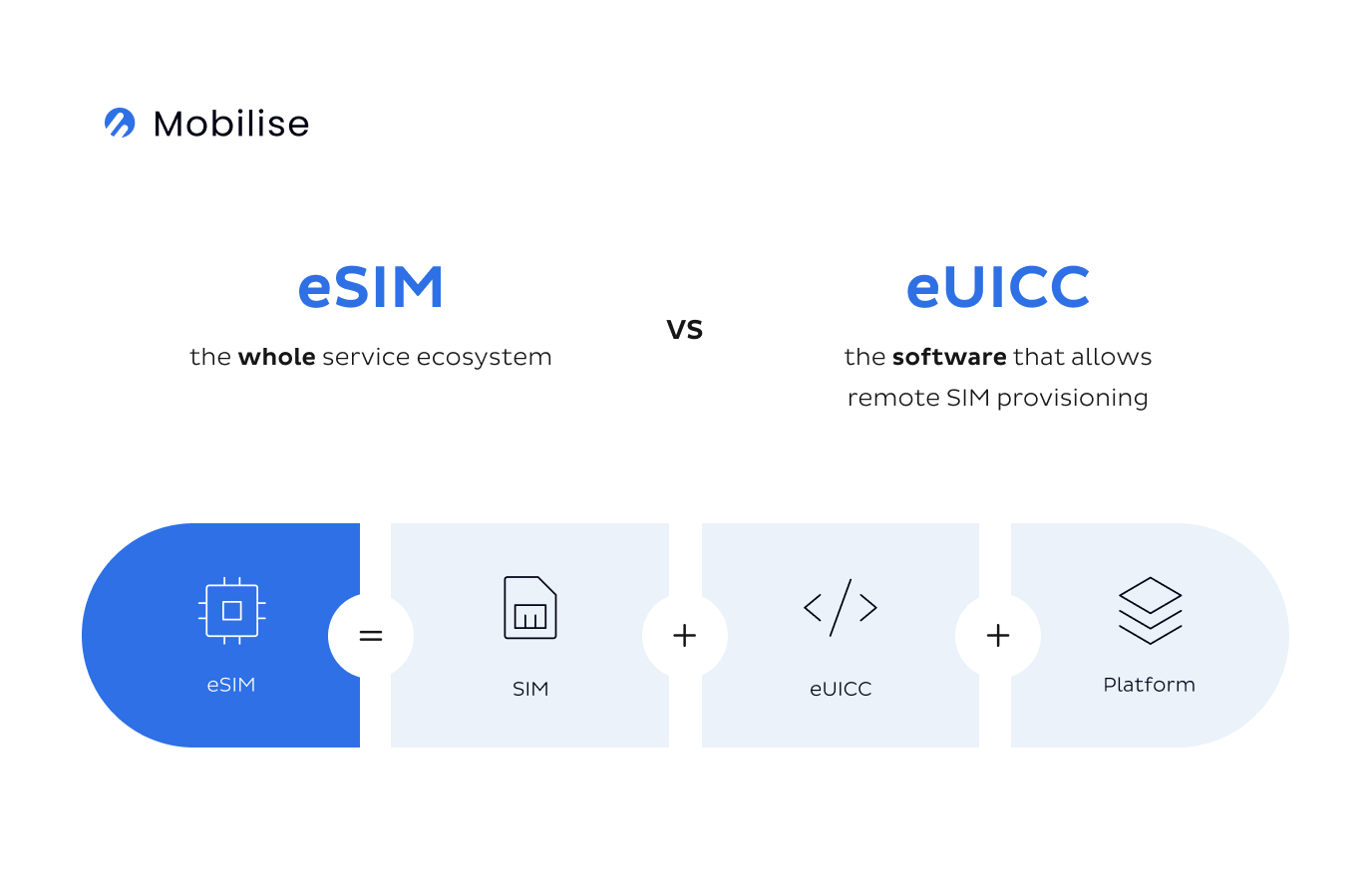
10. What is remote SIM provisioning?
Remote SIM provisioning (RSP) allows for secure and, most importantly, remote operator profile management. This includes the authentication and activation of embedded SIMs and their enabling, disabling and deleting. This over-the-air process removes the need for physical access or SIM card swapping while changing carriers.
11. What is eSIM activation?
eSIM activation is a part of the remote SIM provisioning process. It refers to the activation of eSIMs after they’ve been installed on the device.
To put it into perspective with a real-life example, if a user goes on a holiday in July, they can purchase their travel eSIMs in advance, let’s say, in May. However, they should activate it only when they intend to use it. In this case, around the time of reaching their destination. If the plan bought with the eSIM has an expiration date, it’ll start counting towards that date from the moment the eSIM is activated.
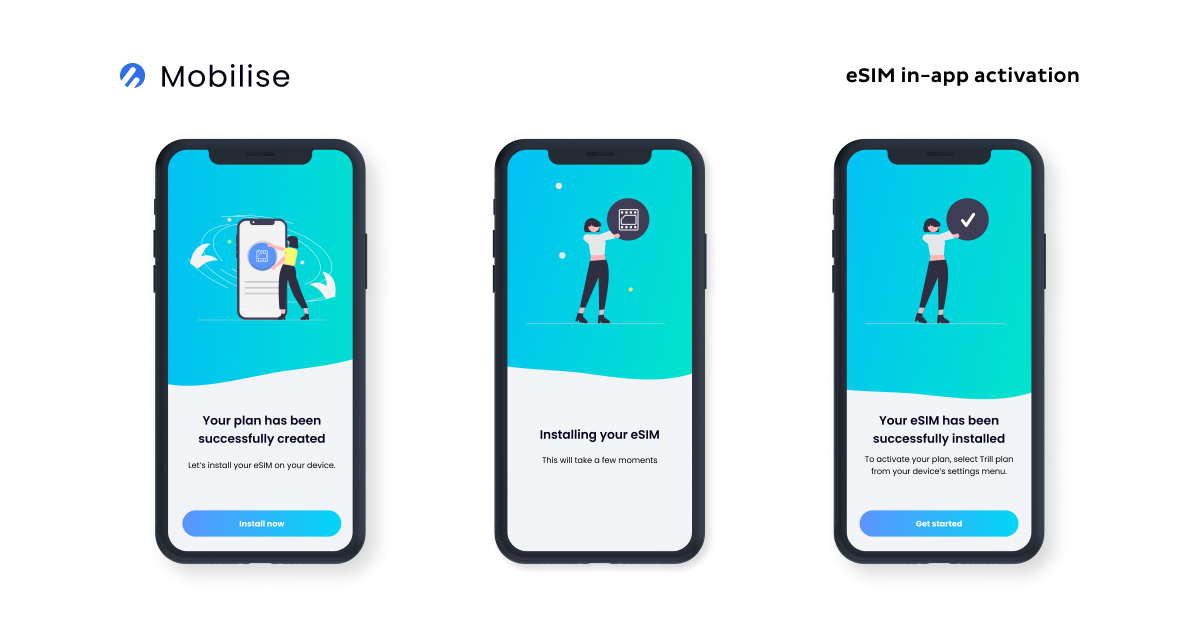
12. What are the main types of eSIM activation?
eSIMs are activated remotely and there are several methods to make it happen:
- Manual activation – a user types in the SM-DP+ address (a code that connects the user’s device to the service provider’s server) through the device’s settings.This is the most complex way of activating eSIM and not the best option to offer as a default to users.
- QR code-based activation – After purchasing a mobile data plan from a provider of choice, the user receives a QR code (usually via email). To activate their eSIM, they need to open the QR code on another device or print it out and scan it with the device they want to activate the eSIM on.This option is easier for less digitally savvy audiences. However, it requires 2 devices or a printer to complete which adds another (and unnecessary) level of complexity to the overall eSIM experience.
- In-app eSIM activation – in this case, the eSIM activation takes place in the provider’s self-care mobile app and can be adopted as part of the overall digital customer onboarding journey.It only takes a tap of a button and up to 60 seconds to complete. In-app eSIM provisioning is the easiest and most user-friendly option of activating eSIM.
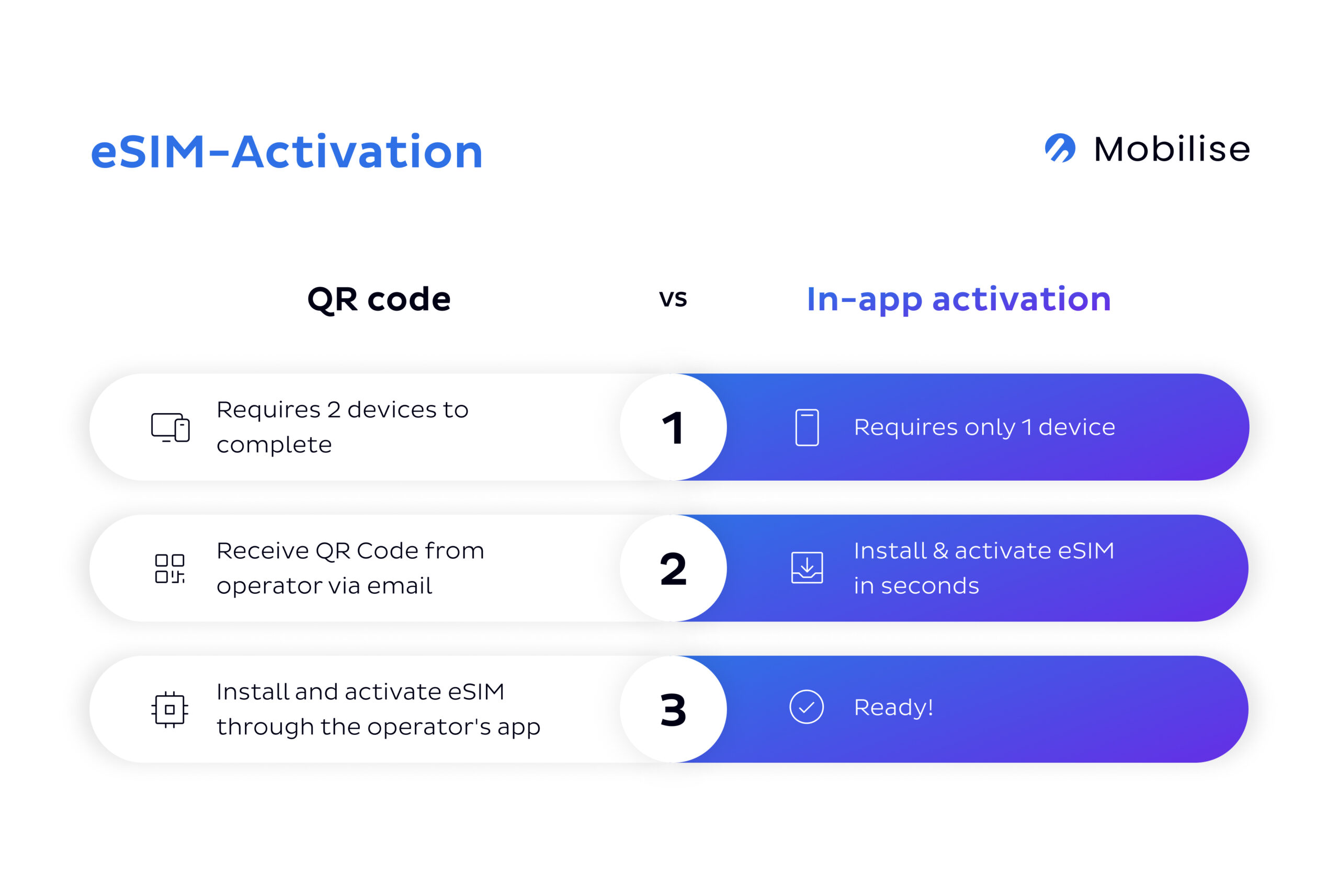
13. How long does eSIM take to activate?
The time needed to activate an eSIM depends on the provider and the activation method they provide.
If it uses QR code-based activation, the process may take a few minutes as it requires the user to jump between the provider’s app and email as well as using multiple devices to complete.
In the case of in-app provisioning (Mobilise’s preferred option), the activation doesn’t require the user to leave the app and usually takes no longer than 60 seconds.
14. eSIM subscription management – what do SPs need to offer eSIM to their consumers?
As per the GSMA standards, an SP needs to acquire a remote SIM provisioning system (SM-DP+) to manage and activate eSIM profiles to the user device over the air.
SM-DP+ is essentially a platform on which the SP stores its eSIM profiles. The platform is also responsible for enabling, disabling, updating, protecting, and deleting profiles.

15. What are the benefits of eSIM?
For businesses?
- Cost savings – for telecom operators the technology eliminates manufacturing and logistics costs by relying on digital and, in turn, less expensive distribution channels.
As folks in the telecom world will know all too well, physical distribution is a costly component of profit & loss (P&L). Physical SIM cards and their packaging represent a significant fixed cost for service providers. On average, it costs 1-2.5 USD to produce, package and deliver one SIM card.
eSIMs cost in comparison is up to 80% lower. The cost only includes the activation fee on the consumer device by the SM-DP+ vendor. No packaging or delivery costs involved.
To put this into perspective, an SP with a 1 million customer base and approximately 50% gross additions per annum could save 1 million US dollars of cost per annum if they switched to 100% eSIM provisioning.
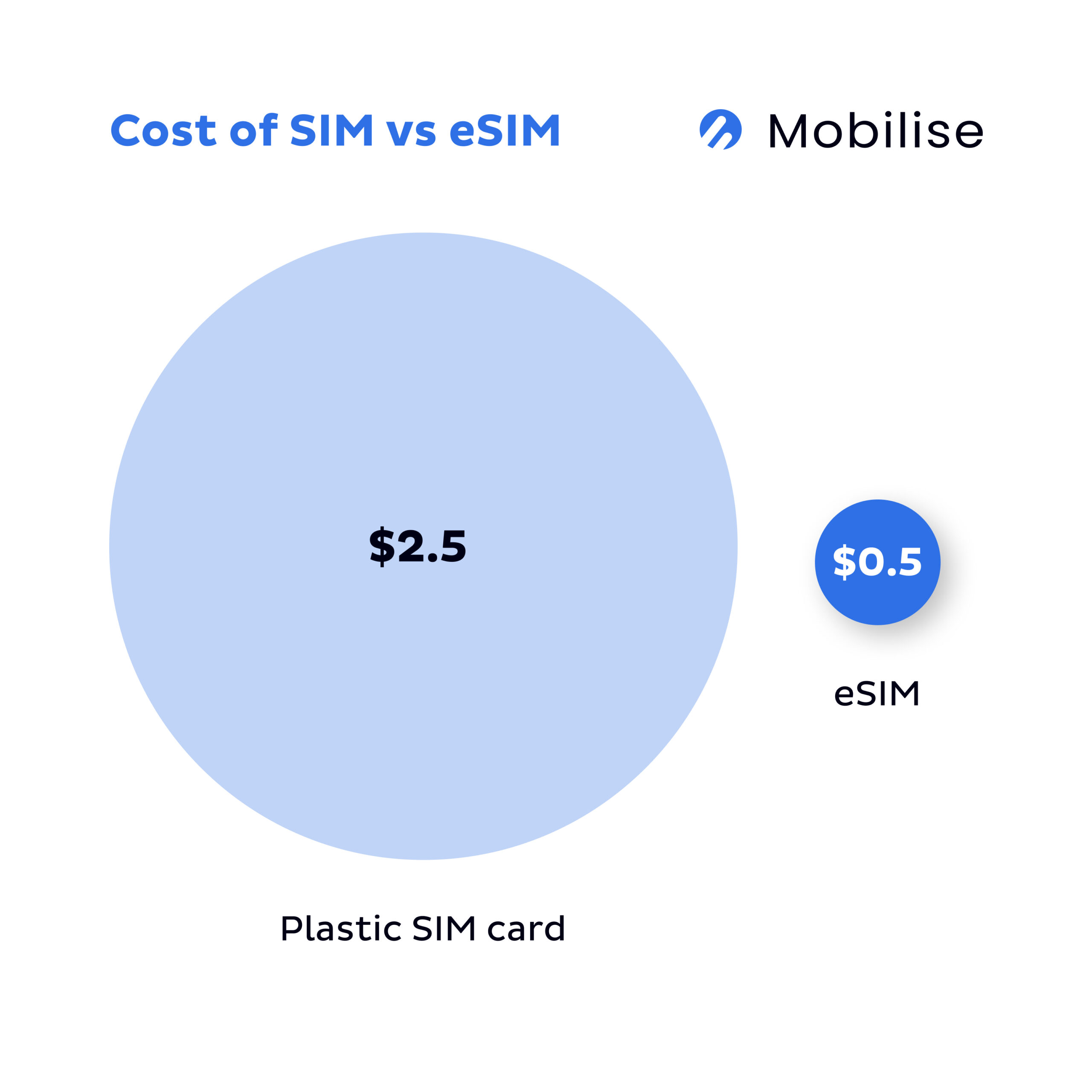
For service providers from other industries, such as travel or finance, embedding connectivity via eSIMs may result in lower operational costs. For example, if a hotel wanted to introduce eSIMs for their guests, they could decrease their Wi-Fi costs in addition to creating a more well-rounded customer experience.
- Revenue enhancement – there are several opportunities to capitalise on eSIMs. Firstly, it allows telecom operators to offer enhanced, multi-device and multi-user subscriptions which drive higher ARPU (average revenue per user) and attract high-spending customers.
Secondly, it enables horizontal market opportunities through embedded connectivity products. For example, introducing eSIMs contributes to a significant increase in ancillary revenue for airlines.
- Improved customer satisfaction and loyalty – In telecoms, eSIMs allow operators to fully digitalise customer onboarding and, in turn, the entire customer journey. In a world driven by digital experiences, digitalisation is what customers expect from their service providers.
In other industries, embedding connectivity via eSIMs enables users to stay connected, wherever they go in a convenient and affordable way. Without the need for purchasing a separate eSIM subscription, or incurring exorbitant roaming charges. It helps to create a more holistic and personalised experience that users are constantly demanding from brands they interact with.
RECOMMENDED READING
eSIM benefits for consumers
- Convenience – Consumers can buy, download, and activate their eSIMs in one app, without the need to visit a store or inserting plastic SIM cards. The whole process takes place online and it’s fully digital making the eSIM experience a breeze.
- Timesaving – Not only is digital onboarding more convenient, it’s also much faster. It can take as short as a few minutes to complete. And eSIM activation itself takes one tap and less than 60 seconds which saves the waiting time for the physical SIM to be shipped or collected from a point of sale (POS).
- Flexibility – As the eSIM customer journey is fully digital and doesn’t require swapping plastic SIM cards it enables users to swap providers more easily. It is further enabled by the fact that one device can hold up to 8 eSIMs. This comes in handy while travelling overseas or when having separate phones for work and personal life.
- Security – eSIM is more secure than traditional SIM cards. It removes the threat related to device theft or loss. In contrast to an embedded SIM, a physical SIM card can be easily discarded after the device has been stolen. eSIM makes the stolen device easier to find and harder to resell.
16. Is eSIM better (than physical SIM)?
This is relative and depends on many factors. However, in our opinion, yes, eSIM is better.
There is one “but” – it must be implemented correctly by the provider and the user experience (UX) must be designed to make the eSIM purchase, activation, and usage as smooth and uncomplicated as possible.
We’ve seen plenty of examples of providers using eSIM technology but having very poor user reviews. What makes the biggest difference between a good and bad eSIM experience (and good and bad user ratings)?
Firstly, the simplicity of the onboarding process. The fewer the steps, the better. Users, especially those using it for the first time, want to be able to complete the process as quickly and least painfully as possible.
They also don’t appreciate lengthy, confusing, or missing instructions. It’s crucial to provide support along every step of the process, explain it clearly, yet concisely and never leave the user without the instruction.
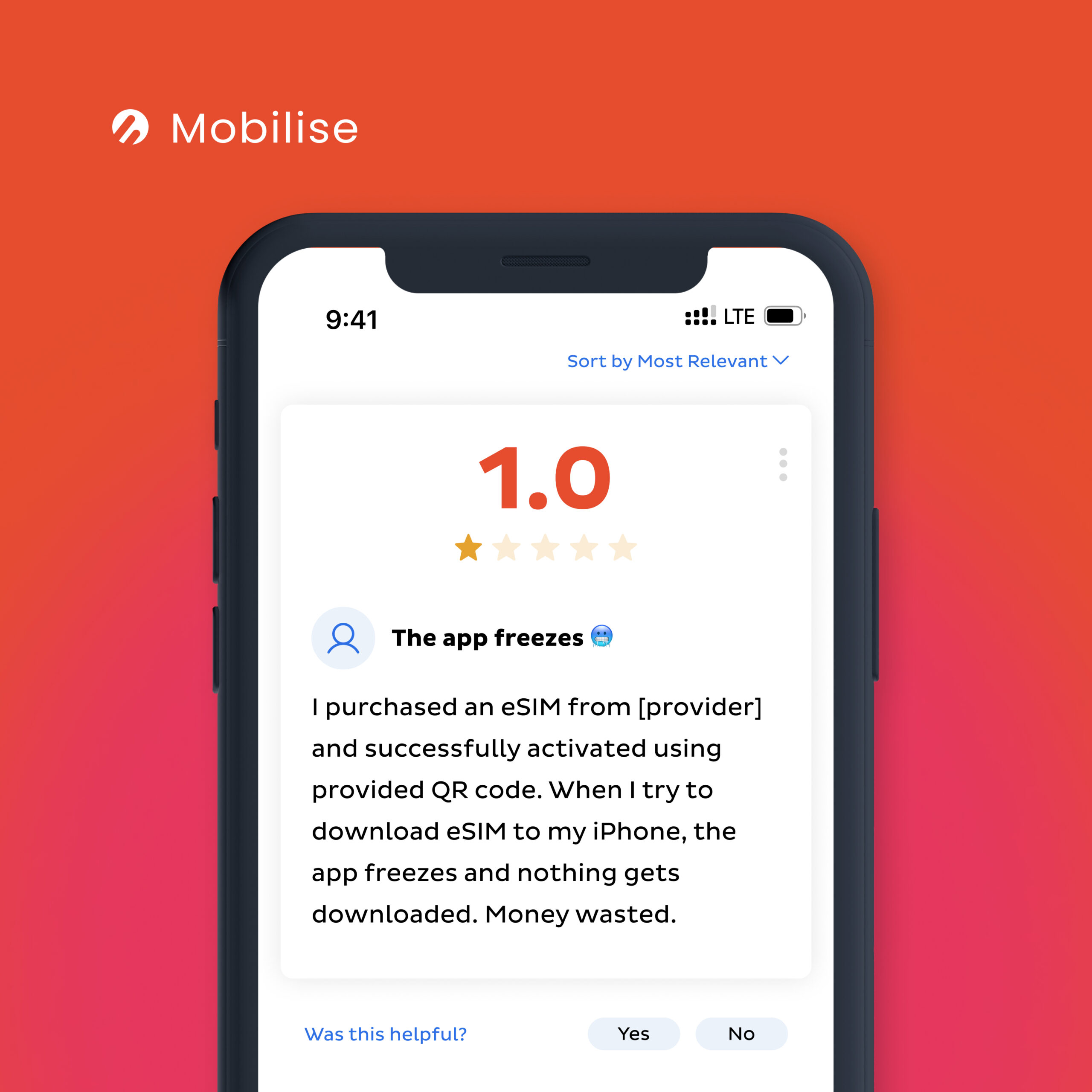
17. Is eSIM safe?
Short answer: yes, eSIMs are safe.
eSIMs perform the same function as removable SIMs but thanks to their embedded nature, they can’t be removed from a device. Therefore, eSIM, with all the information it holds, cannot be stolen without stealing the phone.
In some situations, plastic SIMs are stolen and used for scam activities or to access the victims’ personal information or financial resources.
In a situation when the whole device is stolen, it’ll make it harder to disabling the eSIM is harder that disposing of a removable ISM card to resell the device, making it unattractive for pickpockets.
Nevertheless, hackers and thieves go above and beyond in their craft, so it’s always worth it to be extra careful. Even when it comes to eSIMs.
RECOMMENDED READING
18. Are eSIMs reliable?
eSIM’s reliability depends on multiple factors. In theory, yes, they are. From a technical standpoint, they work in the exact same way as physical SIM cards.
However, people using plastic SIM cards also report issues and challenges ranging from network coverage, to signal strength, to difficulties with getting it to work at all.
The exact same issues can be experienced with eSIMs.
19. Is eSIM faster (than physical SIM)?
While it’s faster to setup and activate or swap eSIMs, the embedded SIMs don’t offer faster internet speeds than physical SIM cards.
Both are a means to authenticating and enabling the service for the user but both have the same functionality once the user is connected to their network of choice.
20. Are eSIMs more sustainable?
Yes! eSIMs are more sustainable than plastic SIM cards.
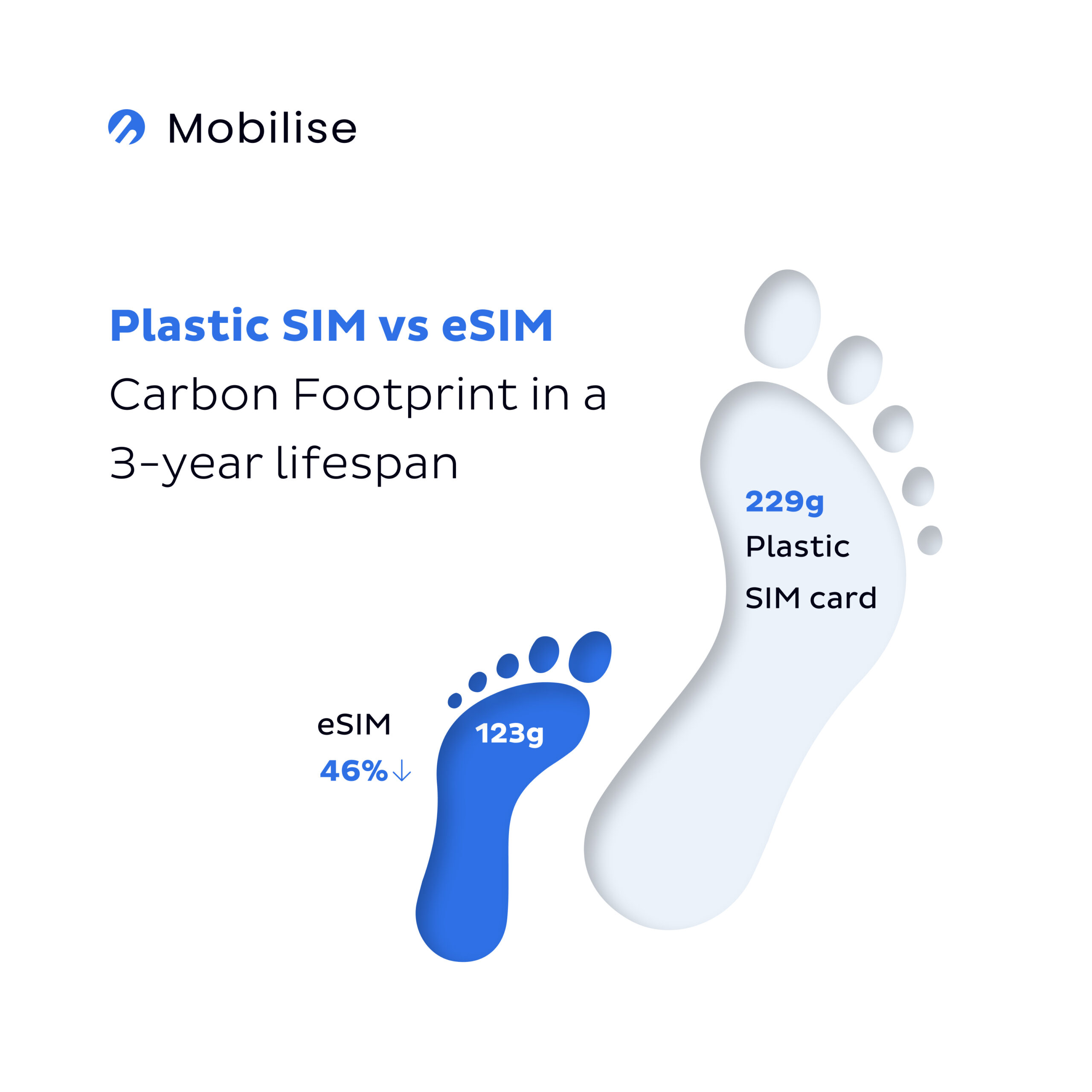
According to our analysis, plastic SIM cards industry generates 140,000 tons of CO2e every year!
Not surprisingly, the traditional SIM card generates around 60% of its emissions through production and distribution logistics. In the case of the eSIMs, only 2% of the emissions are generated in this phase, mainly through computing power and energy consumption for transmitting the QR code.
Even though the insights into the carbon footprint of producing eSIMs are limited, it’s safe to assume it’s significantly lower. They are an integral part of a smartphone so don’t require separate transport or disposal.
They also don’t require the use of any plastic, it’s only the chip that’s soldered into a device. Not to mention that conventional SIMs come enclosed in a larger plastic holder, often up to 8 times bigger than the SIM card itself.
RECOMMENDED READING
21. Are eSIMs data only? Are eSIMs only for data?
While the most popular use for eSIMs are data only, especially for travel eSIMs, there are providers that offer both texts and minutes bundles for eSIMs!
22. How many eSIMs can you have?
The exact number of eSIMs that can be held simultaneously on one device depends on the device manufacturer. The number usually ranges between 1 and 8. But we’ve heard rumours of devices that hold up to 20 eSIM profiles.
For example, the most recent iPhone – iPhone 15 – supports up to 8 eSIMs at once. Samsung devices on the other hand support just 1 eSIM.
That’s not to be confused with how many eSIMs can be active at the same time. Most devices only allow the user to have 1 active eSIM at a time.
Things are a little different with dual-SIM phones. Some devices allow the user to have 1 physical SIM and 1 eSIM active at the same time. Some other dual-SIM devices support 2 active eSIMs.
For example, Apple only supports 2 active eSIMs on iPhone 13 models and later. All earlier models can work in physical SIM + eSIM configuration.
23. What does eSIM compatible mean? What is an eSIM compatible device? Can all phones use eSIM?
eSIM-compatible devices = devices with an eSIM chip soldered inside it.
eSIM-compatible, also called eSIM-enabled, devices are the devices that can support eSIM technology. And only the ones with an eSIM chip inside the device can do so.
Most flagship devices from 2018 onwards are eSIM-compatible but it’s always worth double-checking before purchasing an eSIM plan.
The easiest way to check whether a device is eSIM compatible is to do a quick Google search. There are plenty of eSIM-compatible device list available and they’re updated regularly for most up to date information. One of such list can be found here.
A user can also check if their device is eSIM-enabled via their phone settings.
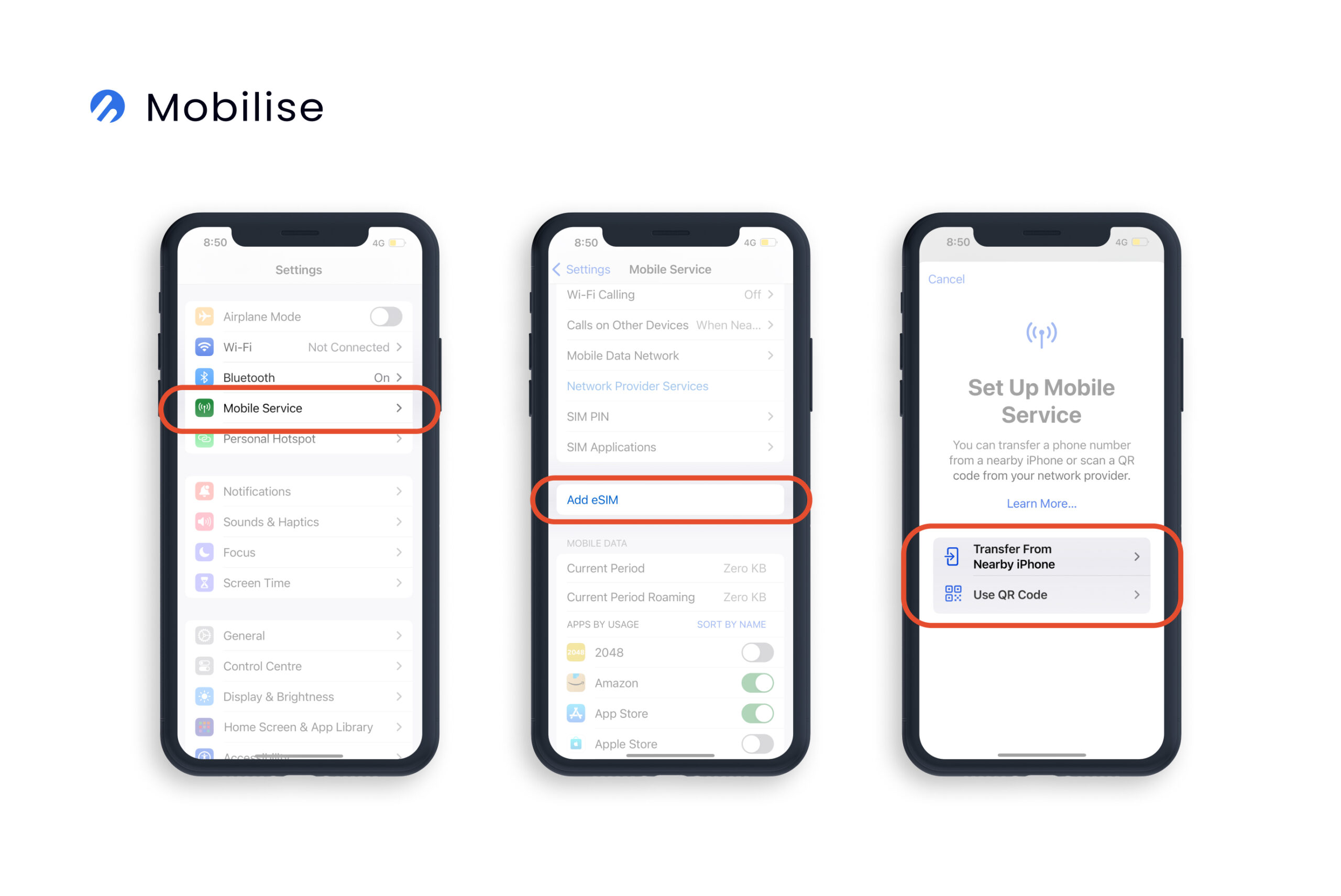
Companies wanting to provide eSIMs to their users should also run a compatibility check before the user has the option to purchase a bundle. Our afore mentioned eSIM app analysis revealed that plenty of providers forget about doing a compatibility check, which results in frustration and unnecessary customer service hassle to process refunds.
24. How many eSIM-enabled smartphones are out there now?
According to our latest analysis, as of March 2023 were 82 eSIM-capable smartphone models available on the market, most of which are offered by Samsung.
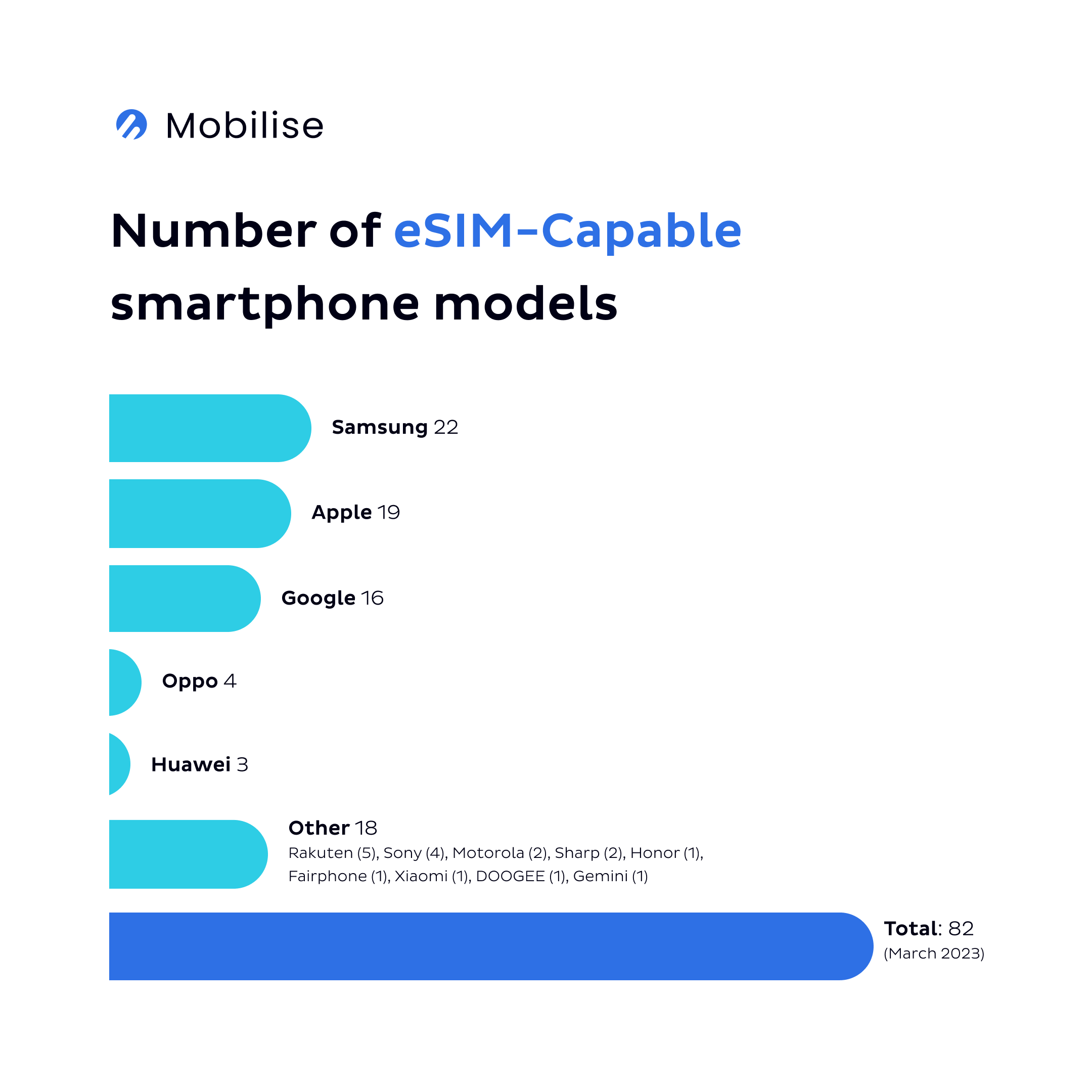
25. How many operators support eSIM worldwide?
As of 2022, 260, which make up 20% of operators globally support eSIMs. On top of this, according to the GSMA’s predictions, 98% of operators globally plan to offer the technology by 2025.
The carriers that support the technology are spread across 88 countries making it almost half of all countries in the world. Most of those countries are in Europe and North America.
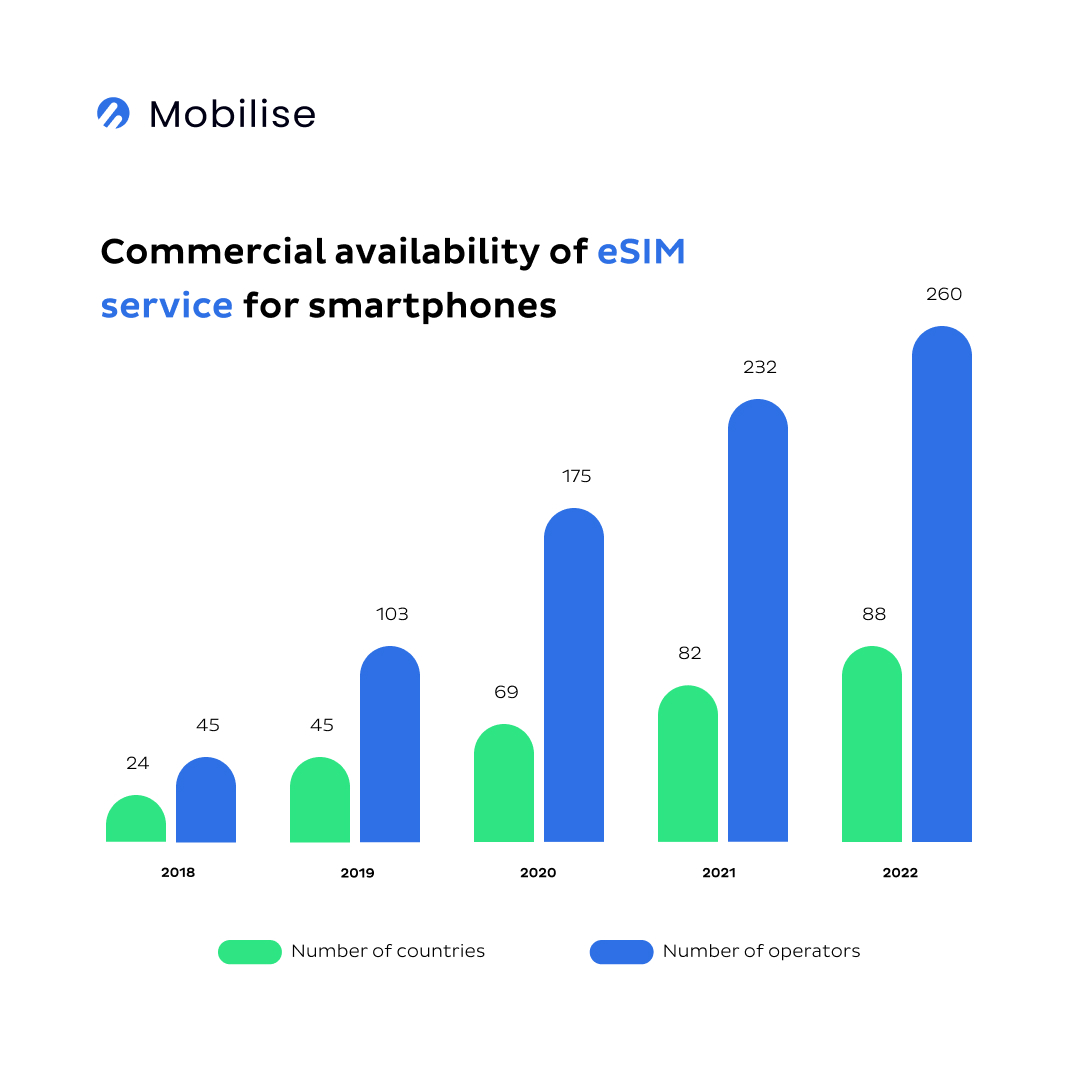
26. Why isn’t eSIM popular?
It’s a ground-breaking technology. It simplifies user onboarding, offers a lot more flexibility and is significantly more sustainable than removable SIM cards.
However, consumer awareness of eSIMs, 7 years after its debut, is still below 30%. Sounds like something doesn’t add up.
The main issue lays on the telecom operators’ side. They aren’t particularly excited about eSIMs as it allows the user to switch networks more easily, risking an increased churn rate for the operator.
They subsequently do next to nothing to promote the technology and educate their consumers about its use and benefits. As seen above, only 20% of operators worldwide have launched eSIM offerings so far. Most of those operators don’t market them at all, keeping them ready only for when it’s inevitable.
This however short-term strategy. Since it’s launch in the consumer market, at least 60 eSIM-only apps entered app marketplaces, offering a more convenient alternative to traditional mobile subscriptions, and roaming. And they don’t save on marketing.
Additionally, thanks to the fully digital nature of eSIMs, connectivity can be embedded virtually everywhere. That opened opportunities for a new revenue stream in industries outside of telecom, such as travel or finance.
Both eSIM-only offerings and adjacent sectors’ efforts to promote eSIMs will boost the awareness and adoption of digital SIMs. The operators that underestimate the technology now, will have to catch up.
27. What is the future of eSIM?
It’s clear that the release of Apple’s eSIM-only phone in the US in September 2022 triggered an increased interest in eSIMs. But is it the future? We believe it is.
eSIMs simplify user onboarding and provides a great alternative for roaming. In a world where customers experience matters more than ever before, eSIM will get the spotlight it deserves. And eventually it’ll become the primary form of getting connected.
Telecom service providers will keep being stubborn and not push the technology to their users, curbing the growth of customer awareness. They will only jump on the bandwagon when there’s no other option left.
eSIM apps will keep entering the competitive landscape, pushing the experience standards to the new levels and educating the users about the benefits of the technology. They’ll be the main drivers of user awareness and adoption of eSIMs.
Other sectors will see an uptake of the technology to diversify their value propositions, generate new revenue streams and staying competitive. Data suggests that the travel industry will be responsible for over 80% of travel eSIM transactions that will be worth close to $10 billion by 2028.
Lastly, eSIMs will become a standard in all smartphones, rather than being reserved only for the flagship devices. Following in Apple’s footsteps, we also foresee more device operators launching eSIM-only devices. Apple proved that the market isn’t fully prepared for the option yet by not expanding its eSIM-only iPhones to Europe with their recent iPhone 15 launch. However, we believe they’ll return to this idea in the future.
RECOMMENDED READING
28. What are the main mistakes hindering the eSIM experience?
eSIMs offer a simplified and convenient user experience but, unfortunately, not all providers have mastered the UX game. On one hand, it’s hard to blame them – eSIMs are still a relatively young technology and hasn’t been explored enough for everyone to know all the tips and tricks.
On the other hand, however, a poor experience discourages plenty of consumers from using eSIMs. Most of consumers are still new to the technology and are weary of what it is and how it works. A poorly explained instruction here, an overcomplicated step there, and the user loses interest in the new technology labelling it as knotty and not worth the hassle.
We identified 6 key mistakes providers tend to make when implementing eSIM:
- Offering pricy data bundles – eSIMs offer an alternative to expensive roaming rates, however, many eSIM app providers offer data bundles that are equally, in not more, expensive as roaming charges.
- Overcomplicating the account set up process – this is usually one of the first steps in user journey. Making it long and not offering alternative sign up options such as existing Google account or Apple ID can frustrate users. Making the process unnecessarily cumbersome right from the get-go.
- Lengthy payment process – the payment process must be smooth, secure and offer a selection of different payment options, such as Apple/Google Pay or PayPal. Some providers forget that and ask the user to fill in the bank account details manually.
- Troublesome installation and activation – only relying on manual or QR code based activation is a thing of the past. Providers should look into switching to in-app activation.
- Hiding data usage – not being able to check the remaining data balance is an irk for users who don’t want to suddenly find themselves without data.
- Poor instructions along the way – given its novelty, the customer journey should be kept simple and explained at every step of the way. Providing confusing, contradicting or lacking instructions can frustrate and discourage the user from completing the transaction.
RECOMMENDED READING
29. Is eSIM worth it?
Yes, yes, and yes! It’s definitely worth it.
eSIMs are worth being discovered by end-users. Although it may seem complicated and thus daunting at the beginning, it’s a much better, faster, and more secure alternative to traditional plastic SIM cards.
It’s also worth it for telecom operators. They may be blinded by the projection of a high churn rate but that can be minimised by providing a seamless experience and offset by cost reductions in other areas of business – logistics, operations, and customer service (among others).
It’s also worth it for service providers outside the telecoms industry. It enables companies across various sectors to add a differentiating factor and create more robust customer experience while adding a new revenue stream.
30. How can Mobilise help service providers offer eSIM for consumers?
At Mobilise, we believe in the transformative power of eSIMs and have prepared a few solutions for all types of service providers:
eSIM white-label app – an eSIM app offering fully digital customer journey. It’s for companies who don’t have a digital eSIM presence and would like to offer it through a mobile app.
eSIM SDK – a solution for all service providers that already have an app and would like to supplement it with a connectivity feature. Perfect for telecoms operators who haven’t launched eSIMs yet as well as all other sectors – travel, finance and more!
